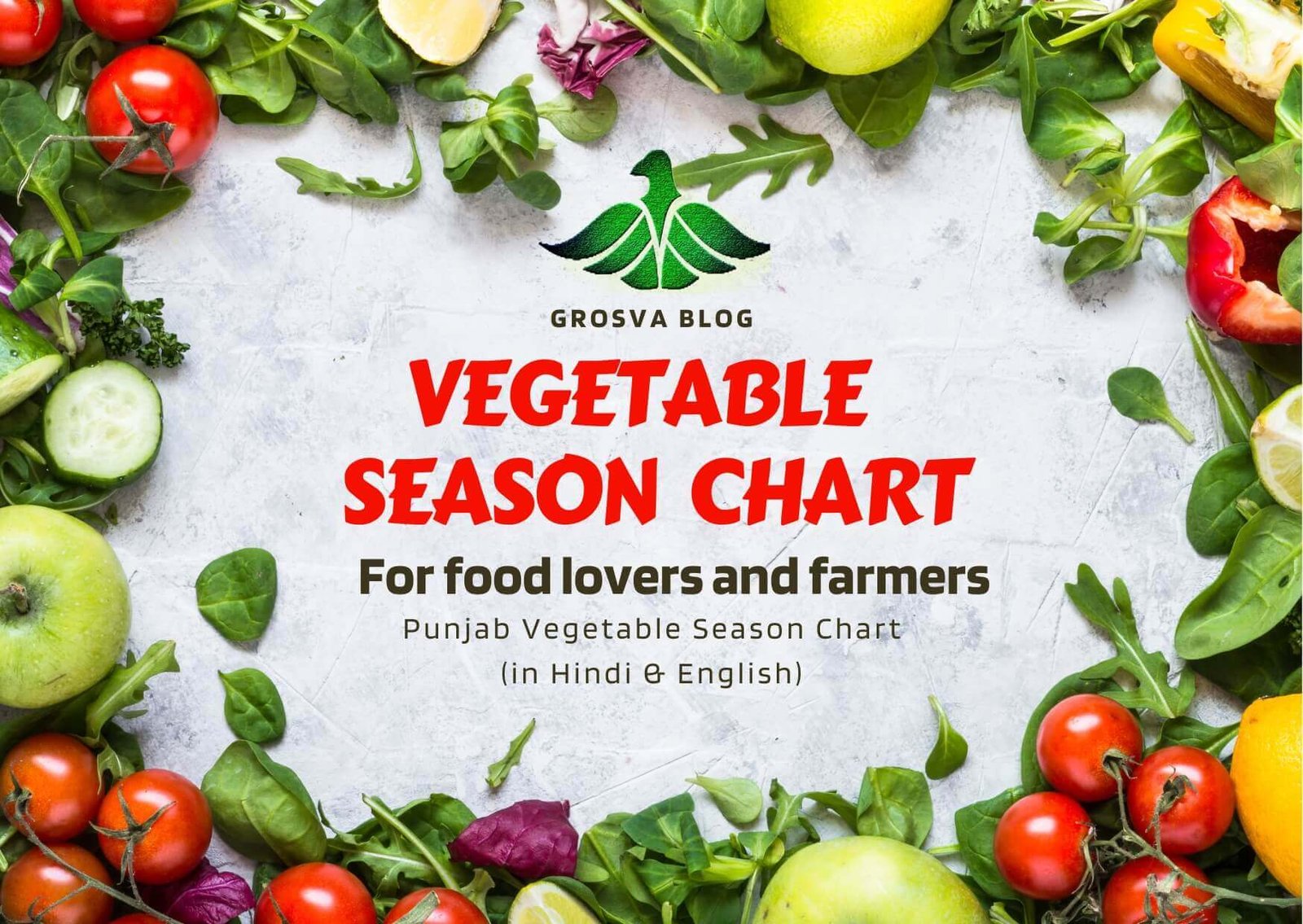Blog
Vegetable Season Chart: Month-by-Month Guide for Perfect Harvest

Overview:
Seasonal food is loved by many of us. There are many who love to eat seasonal food so much that they wait only for certain times throughout the year. Similarly, there are many people who prefer to cultivate themselves.You will find here the list of best seasonal fruits and Vegetable Season Chart to plant in Punjab according to Indian climate.
Kharif Season- Monsoon Season (June to September)
Good yield of tomato, cucumber, brinjal, okra and pumpkin is available in this month. This warm and humid climate is required to grow this crop.
Rabi / Winter Season (October to March):
Winter is a great time to grow crops like spinach, peas, cauliflower, carrots and cabbage. Because winter temperatures are low and crops need cool temperatures and low humidity at this critical time of the year.
Zaid Season (Summer) March to June:
Summer begins after winter. Green vegetables like watermelon, bitter gourd, bitter gourd, cilantro are in fruit during this time. These vegetables require high temperature and moderate rainfall otherwise the yield is not good.
1. Kharif Season – June to September
Kharif season in Punjab coincides with the monsoon rains. which provides a suitable environment for growing warm-season crops. This season is very good for vegetables that require high humidity and heat.
| Vegetable (English – Hindi) | Planting Time | Harvest Time |
| Beans (Green) – फलियां (हरी) | June-July | 60-90 days after planting |
| Brinjal (Eggplant) – बैंगन | June-July | 60-120 days after planting |
| Cucumber – खीरा | June-July | 50-70 days after planting |
| Okra (Ladyfinger) – भिंडी | June-July | 50-60 days after planting |
| Sweet Corn – मक्का | June-July | 80-100 days after planting |
| Tomato – टमाटर | June-July | 60-80 days after planting |
| Chili (Green) – मिर्च (हरी) | June-July | 60-90 days after planting |
| Bottle Gourd – लौकी | June-July | 70-90 days after planting |
| Bitter Gourd – करेला | June-July | 60-90 days after planting |
| Pumpkin – कद्दू | June-July | 90-120 days after planting |
| Cowpea – लोबिया | June-July | 60-80 days after planting |
| Radish (Summer) – मूली (गर्मी) | June-July | 30-40 days after planting |
| Capsicum (Bell Pepper) – शिमला मिर्च | June-July | 70-90 days after planting |
| Lemon Cucumber – नींबू खीरा | June-July | 60-70 days after planting |
| Long Melon – लंबा खरबूजा | June-July | 80-100 days after planting |
| Amaranth (Red & Green) – चौलाई (लाल और हरी) | June-July | 40-60 days after planting |
| Squash – लौकी | June-July | 80-100 days after planting |
2. Rabi Season (Winter Season) – October to March
The Rabi season in Punjab is characterized by cooler temperatures, which are perfect for growing cold-weather vegetables like leafy greens, root vegetables, and cabbage-family crops.
| Vegetable (English – Hindi) | Planting Time | Harvest Time |
| Cabbage – बंद गोभी | October-November | 80-120 days after planting |
| Cauliflower – फूलगोभी | October-November | 60-100 days after planting |
| Carrot – गाजर | October-November | 90-120 days after planting |
| Spinach – पालक | October-November | 30-50 days after planting |
| Beetroot – चुकंदर | October-November | 60-90 days after planting |
| Lettuce – लेटस | October-November | 40-60 days after planting |
| Radish – मूली | October-November | 30-40 days after planting |
| Peas – मटर | October-November | 60-80 days after planting |
| Onion (from sets) – प्याज (सेट से) | October-November | 90-120 days after planting |
| Garlic – लहसुन | October-November | 8-9 months after planting |
| Coriander – धनिया | October-November | 30-40 days for leaves, 90-120 days for seeds |
| Fenugreek (Methi) – मेथी | October-November | 20-30 days for leaves, 60-70 days for seeds |
| Mustard Greens – सरसों के पत्ते | October-November | 40-60 days after planting |
| Kale – केल | October-November | 60-80 days after planting |
| Chard – चर्ड | October-November | 50-60 days after planting |
| Collard Greens – कॉलर्ड ग्रीन | October-November | 60-90 days after planting |
| Fennel – सौंफ | October-November | 90-120 days after planting |
| Caraway – जीरा | October-November | 60-90 days after planting |
| Turnip – शलरी | October-November | 60-90 days after planting |
| Chives – चाइव्स | October-November | 60-90 days after planting |
3. Zaid Season (Summer Season) – March to June
The Zaid season is a short transitional period between the winter and monsoon, characterized by rising temperatures. It’s suitable for fast-growing, heat-tolerant vegetables.
| Vegetable (English – Hindi) | Planting Time | Harvest Time |
| Cucumber – खीरा | March-April | 50-70 days after planting |
| Watermelon – तरबूज | March-April | 80-100 days after planting |
| Pumpkin – कद्दू | March-April | 90-120 days after planting |
| Bitter Gourd – करेला | March-April | 60-90 days after planting |
| Bottle Gourd – लौकी | March-April | 70-90 days after planting |
| Lettuce – लेटस | March-April | 40-60 days after planting |
| Chili – मिर्च | March-April | 60-90 days after planting |
| Coriander – धनिया | March-April | 30-40 days for leaves, 90-120 days for seeds |
| Radish (Summer) – मूली (गर्मी) | March-April | 30-40 days after planting |
| Amaranth (Red & Green) – चौलाई (लाल और हरी) | March-April | 40-60 days after planting |
| Basil – तुलसी | March-April | 50-60 days after planting |
| Cantaloupe – खरबूजा | March-April | 80-100 days after planting |
| Bok Choy – बोक चॉय | March-April | 30-50 days after planting |
| Moringa – सहजन | March-April | 70-90 days after planting |
| Okra – भिंडी | March-April | 50-60 days after planting |
| Kale – केल | March-April | 60-80 days after planting |
| Chili (Long Red) – मिर्च (लंबी लाल) | March-April | 60-90 days after planting |
| Chinese Cabbage – चीनी गोभी | March-April | 40-60 days after planting |
| Squash – लौकी | March-April | 80-100 days after planting |
| Green Onion (Scallions) – हरा प्याज | March-April | 60-90 days after planting |


When is the best time to plant vegetables in Punjab?
In Punjab, the best time to plant vegetables depends on the season:
Kharif Season (Monsoon): June to September is ideal for heat-loving vegetables like tomatoes, cucumbers, brinjal, and okra. The monsoon rains and warm temperatures provide the perfect environment for these crops.
Rabi Season (Winter): October to March is perfect for cool-season vegetables such as spinach, peas, cauliflower, carrots, and cabbage. These crops thrive in the cool temperatures of winter.
Zaid Season (Summer): March to June is suitable for fast-growing, heat-tolerant vegetables like bitter gourd, watermelon, and bottle gourd. This transitional period between winter and the monsoon sees rising temperatures that these crops prefer.
What vegetables can I harvest in the winter (Rabi) season in Punjab?
During the Rabi (Winter) Season (October to March), you can harvest the following vegetables in Punjab:
Leafy Greens: Spinach, lettuce, kale, and fenugreek
Root Vegetables: Carrots, beetroots, and radishes
Cabbage Family: Cabbage, cauliflower, mustard greens, and collard greens
Other Vegetables: Peas, onions (from sets), garlic, and coriander (both for leaves and seeds)
These vegetables thrive in the cooler temperatures and low humidity typical of the winter season.
How long does it take to harvest vegetables in Punjab?
The time to harvest vegetables in Punjab varies depending on the type of crop:
Kharif (Monsoon) Vegetables: Most crops planted in June or July, such as tomatoes, cucumbers, and okra, take between 50 to 120 days to mature.
Rabi (Winter) Vegetables: Vegetables planted in October-November, like cabbage, carrots, and spinach, typically take 30 to 120 days to reach harvest.
Zaid (Summer) Vegetables: Summer crops like watermelon, pumpkin, and bitter gourd, which are planted from March-April, can take anywhere from 30 to 120 days depending on the variety.


Nice knowledge from you ….